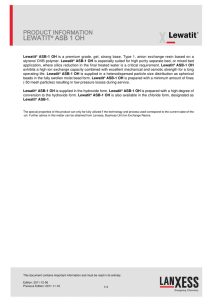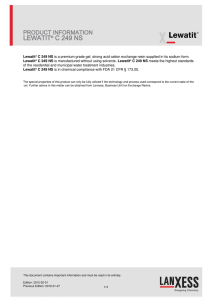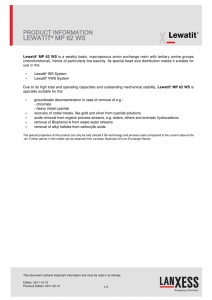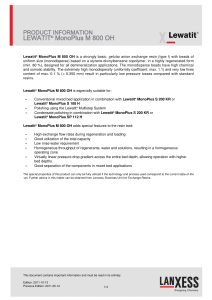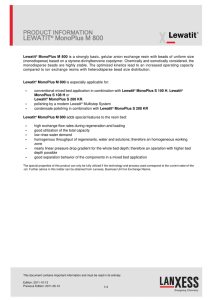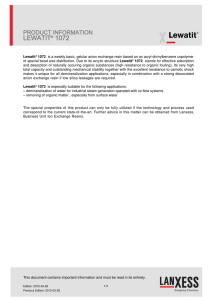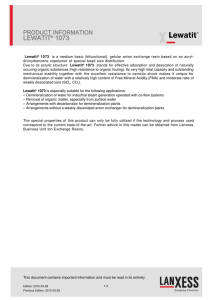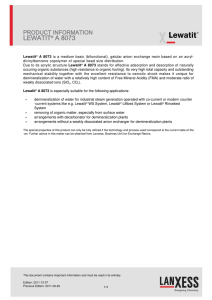Lewatit S 6268
advertisement
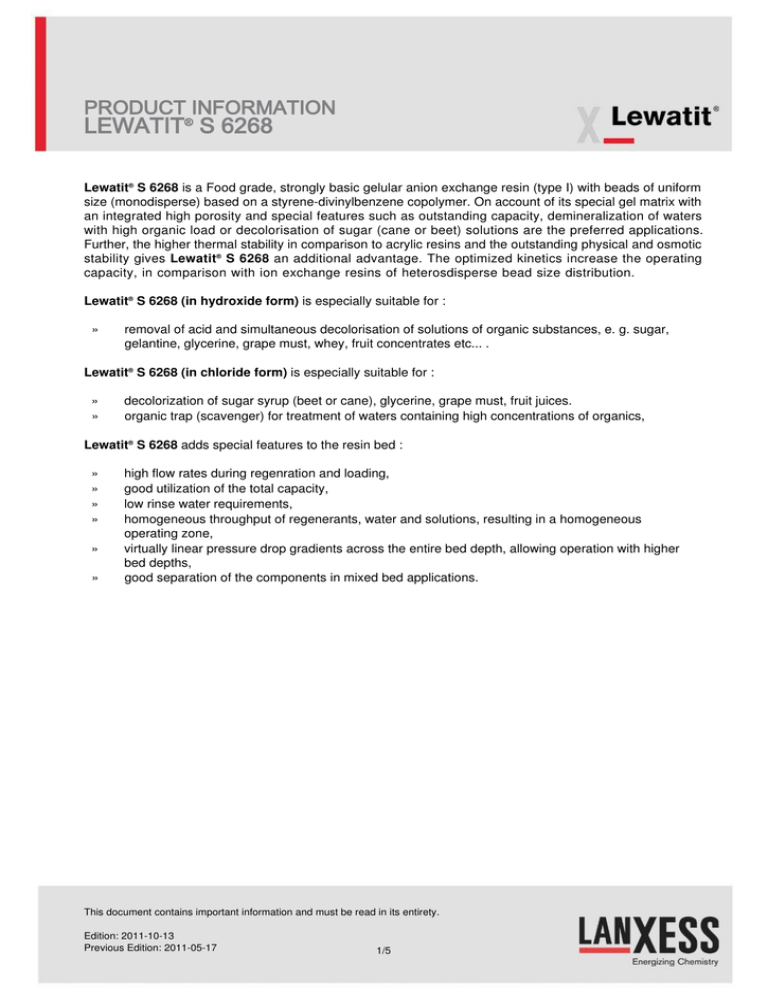
Lewatit® S 6268 is a Food grade, strongly basic gelular anion exchange resin (type I) with beads of uniform size (monodisperse) based on a styrene-divinylbenzene copolymer. On account of its special gel matrix with an integrated high porosity and special features such as outstanding capacity, demineralization of waters with high organic load or decolorisation of sugar (cane or beet) solutions are the preferred applications. Further, the higher thermal stability in comparison to acrylic resins and the outstanding physical and osmotic stability gives Lewatit® S 6268 an additional advantage. The optimized kinetics increase the operating capacity, in comparison with ion exchange resins of heterosdisperse bead size distribution. Lewatit® S 6268 (in hydroxide form) is especially suitable for : » removal of acid and simultaneous decolorisation of solutions of organic substances, e. g. sugar, gelantine, glycerine, grape must, whey, fruit concentrates etc... . Lewatit® S 6268 (in chloride form) is especially suitable for : » » decolorization of sugar syrup (beet or cane), glycerine, grape must, fruit juices. organic trap (scavenger) for treatment of waters containing high concentrations of organics, Lewatit® S 6268 adds special features to the resin bed : » » » » » » high flow rates during regenration and loading, good utilization of the total capacity, low rinse water requirements, homogeneous throughput of regenerants, water and solutions, resulting in a homogeneous operating zone, virtually linear pressure drop gradients across the entire bed depth, allowing operation with higher bed depths, good separation of the components in mixed bed applications. This document contains important information and must be read in its entirety. Edition: 2011-10-13 Previous Edition: 2011-05-17 1/5 When using Lewatit® S 6268 to treat potable water and the aqueous solutions listed above, special care should be given to the initial cycles of the new resin. Please refer to the recommended start-up conditions available on request. The special properties of this product can only be fully utilized if the technology and process used correspond to the current state-of-the -art. Further advice in this matter can be obtained from Lanxess, Business Unit Ion Exchange Resins. This document contains important information and must be read in its entirety. Edition: 2011-10-13 Previous Edition: 2011-05-17 2/5 General Description Ionic form as shipped Functional group Matrix Structure Appearance Clquarternary amine, type I crosslinked polystyrene gel type beads yellow, translucent Physical and Chemical Properties metric units max. mm Uniformity Coefficient* Mean bead size* Bulk density Density Water retention (+/- 5 %) g/l approx. g/ml wt. % Total capacity* Volume change Stability Cl --> OH at pH-range Storability Storability of the product temperature range - 0.62 (+/- 48 This document contains important information and must be read in its entirety. 3/5 - 55 1.2 25 0 max. years °C 0.05 700 1.08 min. eq/l max. vol. % - * Specification values subjected to continuous monitoring. Edition: 2011-10-13 Previous Edition: 2011-05-17 1.1 - 14 2 -20 - 40 ) Recommended Operating Conditions* metric units max. °C Operating temperature Operating pH-range OH: Cl: 70 90 0 Bed depth Specific pressure drop Pressure drop Linear velocity operation Linear velocity backwash (20 °C) Bed expansion Freeboard (20 °C, per m/h) backwash (extern / intern) min. mm approx. kPa*h/m2 max. kPa max. m/h (15 °C) 12 800 1.0 200 agua: azúcar: approx. m/h 7 approx. vol. % vol. % 80 Regenerant - 5 - 40 2-5 - 9 11 - 100 NaOH NaCl + NaOH Counter current regeneration level WS-System concentration approx. g/l NaOH: NaCl + NaOH: 50 - 80 200- 20 approx. wt. % NaOH: NaCl + NaOH: 2-4 10+ 1-2 Linear velocity regeneration Linear velocity rinsing Rinse water requirement slow / fast approx. m/h approx. m/h approx. BV 5 5 4 * The recommended operating conditions refer to the use of the product under normal operating conditions. It is based on tests in pilot plants and data obtained from industrial applications. However, additional data are needed to calculate the resin volumes required for ion exchange units. These data are to be found in our Technical Information Sheets. This document contains important information and must be read in its entirety. Edition: 2011-10-13 Previous Edition: 2011-05-17 4/5 Additional Information & Regulations Safety precautions Strong oxidants, e.g. nitric acid, can cause violent reactions if they come into contact with ion exchange resins. Toxicity The safety data sheet must be observed. It contains additional data on product description, transport, storage, handling, safety and ecology. Disposal In the European Community Ion exchange resins have to be disposed, according to the European waste nomenclature which can be accessed on the internet-site of the European Union. Storage It is recommended to store ion exchange resins at temperatures above the freezing point of water under roof in dry conditions without exposure to direct sunlight. If resin should become frozen, it should not be mechanically handled and left to thaw out gradually at ambient temperature. It must be completely thawed before handling or use. No attempt should be made to accelerate the thawing process. This information and our technical advice – whether verbal, in writing or by way of trials – are given in good faith but without warranty, and this also applies where proprietary rights of third parties are involved. Our advice does not release you from the obligation to check its validity and to test our products as to their suitability for the intended processes and uses. The application, use and processing of our products and the products manufactured by you on the basis of our technical advice are beyond our control and, therefore, entirely your own responsibility. Our products are sold in accordance with the current version of our General Conditions of Sale and Delivery. This document contains important information and must be read in its entirety. Edition: 2011-10-13 Previous Edition: 2011-05-17 5/5 Lenntech info@lenntech.com Tel. +31-152-610-900 www.lenntech.com Fax. +31-152-616-289
